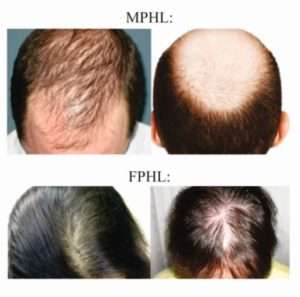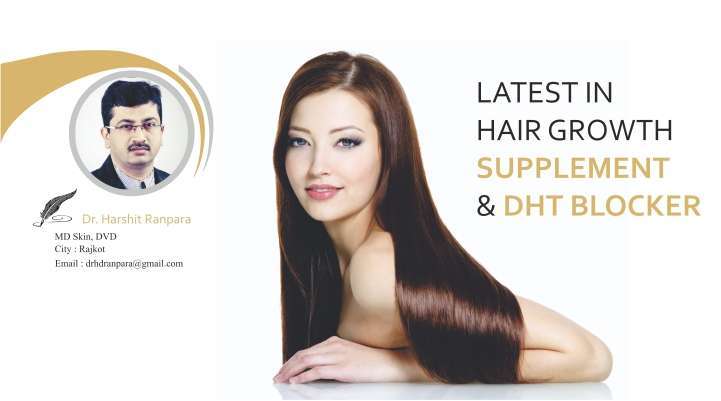Due to increased awareness of the sexual side effects of Finasteride and Dutasteride because of internet, people think that these medicines many lead to impotency. The truth of the matter is that the decrease in the libido is 0.05% and that is also temporary side effect. But all said and done, we cannot deny the negative mindset of the patients towards Finasteride and Dutasteride. Whenever a patient is prescribed Finasteride and Dutasteride – his answer is that “it is better to be bald than to be important.” Because of this mindset, it is imperative that we prescribe other health supplements – DHL blocker which has no sexual side effects.
So, we are in need for some natural DHT Blocker which has no sexual side effects with multiple effects like stimulation hair growth, prevent hair loss and with Anti-Androgenic properties and Anti-inflammatory benefits.
They are Melatonin, Beta-Sitosterol, Soy Isoflavones, Green Tea Extract and Omega 3 and 6.
Ninety-five percent of hair loss in men is caused by Androgenetic Alopecia.
Main Causes of Androgenetic Alopecia:
Hair loss can be due to androgens, genetics, micro inflammation, disruption or deregulation of hair growth cycle. Apart from androgens many more factors affect hair growth, stress, pollution, nutrition, lifestyle, prolonged illness, medications, metabolic disease, smoking, alcohol, which disrupt or deregulate the hair growth cycle, have been associated with hair loss, thinning & poor growth.
These below factors affect the hair growth directly and also make the hair rusty, more sensitive & susceptible to the action of androgens.
Sex Hormone Binding Globulin (SHBG) –
There is a clinically established inverse relationship between sex hormone binding globulin (SHBG) and androgenetic alopecia (AGA) in women. Increasing of the SHBG levels reduce bioavailability of sex hormones.
5 Alfa Reductase-
5 Alfa Reductase isoenzymes are responsible for converting free testosterone into DHT. There are 2 types of isoenzymes: type 1 – in scalp, mainly located in the sebaceous gland and type 2 in the hair follicle. Inhibition of type 2 – 5 Alfa Reductase is an effective treatment of AGA.
Oxidative Stress-
which contributes to the aging process of the hair follicle, hair graying and hair loss. With age, the free radical’s production increases, while the endogenous defence mechanisms decrease. Here, Anti-oxidants can have important role in prevention and treatment of hair loss with oxidative stress.
Inflammation –
is Commonly associated with androgenetic alopecia and other scalp disorders. Inflammatory cytokines can accelerate development of androgenetic alopecia and induce telogen. Microscopic follicular inflammation in the pathogenesis of AGA.

There are few molecules which are widely used in western countries and with very good DHT Blocking effects and anti-androgenic properties with multiple actions to reduce the Causes of Androgenetic Alopecia.
Soy Isoflavones (seed) ext.
Soy Isoflavones, usually Genistein and Daidzein, are bioflavonoids found in soy products and other plants that are able to interact with various hormones such as estrogenic. Isoflavones are a class of phytoestrogens — plant-derived compounds with estrogenic activity. Soybeans and soy products are the richest sources of isoflavones in the human diet.
- The singular consumption of Soy lowers DHT by 15%.
- The Combination of Soy Isoflavones and Green Tea lowers DHT by 80% in animal models.
- Anti-inflammatory benefits on androgen induced inflammation.
- Soy Isoflavones facilitate Equal production and anti-androgen that neutralizes DHT effects.
- Increase SHBG levels.
- Low levels of SHBG are known to be associated with Male and Female PatternBaldness.
- Modulates estrogen-dependent mechanisms and/or inflammatory activity associated to alopecia.
Green Tea (leaf) ext.
Catechins are naturally present in green tea. Catechins help in repressing DHT or dihydrotestosterone which are the main cause for hair loss. This can help in avoiding hair fall naturally. The anti-inflammatory properties of green tea boost the growth of hair.
- Antioxidant Benefits
- Oxidative stress directly affects the cell membrane and facilitates entry of DHT, DHEAS and other damaging factors into the cell.
- Reactive oxygen species (ROS) cause sebaceous gland hyperplasia, promotes increased type I 5-AR enzyme activity and higher DHT formation.
- Provides Anti-inflammatory benefits
- Increases SHBG levels
- Hair Growth Stimulators
- Epigallocatechin-3-gallate, the main polyphenol in green tea, stimulates human hair growth and prolongs the anagen phase through proliferative and anti-apoptotic effects on human dermal papilla cells.
Omega 3 & 6
- EPA (Eicosapentaenoic acid)
- DHA (Docosahexaenoic acid)
Omega-3
fatty acids—also called ω-3 fatty acids or n-3 fatty acids—
The three types of omega-3 fatty acids involved in human physiology are α-linolenic acid (ALA) (found in plant oils), eicosapentaenoic acid (EPA), and docosahexaenoic acid (DHA) (both commonly found in marine oils). Marine algae and phytoplankton are primary sources of omega-3 fatty acids.Omega-3 fatty acids are important for normal metabolism.
Omega-6
fatty acids (also referred to as ω-6 fatty acids or n-6 fatty acids). The biological effects of the omega-6 fatty acids are largely produced during and after physical activity for the purpose of promoting growth and during the inflammatory cascade to halt cell damage and promote cell repair by their conversion to omega-6 eicosanoids that bind to diverse receptors found in every tissue of the body.
- Provide potent anti-inflammatory properties.
- Inflammation is commonly associated with androgenetic alopecia and other scalp disorders.
- Inflammatory cytokines induce telogen and can accelerate progression of androgenetic alopecia.
Beta Sitosterol complex
β-Sitosterol (beta-sitosterol) is one of several phytosterols (plant sterols) with chemical structures similar to that of cholesterol. Sitosterols are white, waxy powders with a characteristic odor. They are hydrophobic and soluble in alcohols. It might help reduce cholesterol levels by limiting the amount of cholesterol that is able to enter the body. It can also bind to the prostate to help reduce swelling (inflammation).
- Noncompetitive 5 alfa reductases type 1 and 2 inhibitors.
- Utilized in the treatment of androgenic alopecia and benign prostatic hyperplasia.
- Provides estrogen and androgen receptor blocking.
- Increases Sexual Hormone Binding Globulin (SHBG) levels.
- Provides anti-inflammatory benefits.
Saw palmetto
Saw palmetto is a natural herb which effectively combats hair loss. A small palm
which grows in warm climates such as the Southeastern part of United States produces a red fruit.
Saw Palmetto is an herbal DHT inhibitor. It has similar mechanism of action to
finasteride, but it doesn’t affect the rest of the organism and thus have no side effects associated with finasteride and other prescription drugs.
Just like minoxidil (A minoxidil was previously used for heart related issues) Saw
palmetto basically was used for treatment of enlargement of prostate and how being widely for male pattern baldness as the cause of both is similar i.e. higher level of DHT. When taken orally, it may be an effective antiandrogen by lowering dihydrotestosterone (DHT) levels in the body by blocking 5-alpha reductase enzymes. Additionally, it is said to block receptor cites on cells which is required for cells to absorb DHT. Tests have also been performed on its use in the treatment of benign prostatic disease, which similarly to androgenic alopecia, depends on the production of DHT.
- Inhibits conversion from testosterone to DHT by blocking 5-alpha reductase
enzyme - Inhibits binding of DHT to receptors, so blocks DHT’s action
- Mode of action similar to finasteride without its side effects
- Helps in normalizing hormonal levels (in female pattern baldness)
- Saw palmetto’s effects on hormone metabolism may have important
implications for hormone restoration programs as well as for supporting healthy
hair growth and preventing hair loss.
Melatonin Precursor
A precursor to melatonin, the hormone that regulates sleep cycles. Melatonin is produced from the neurotransmitter serotonin in a daily rhythm that peaks at night.
Melatonin is produced at several sites in the body: the pineal gland, the retina and the intestine.
In animals, melatonin is involved in the entrainment (synchronization) of the circadian rhythms including sleep-wake timing, blood pressure regulation, seasonal reproduction, and many others.
- The anagen hair follicle (HF) produces melatonin in loco as a cyto-protective and apoptosis-suppressive agent.
- Prevents telogen as it reduces spontaneous apoptosis in HF keratinocytes.
- Prevents stress-induced hair loss.
- Melatonin can protect the follicle from systemic “stressors” associated with high levels of norepinephrine.
- Melatonin is a potent antioxidant – free radical scavenger with capacity to stimulate DNA repair.
- Interacts with androgen receptors and has anti-androgenic properties.
*-*-*






